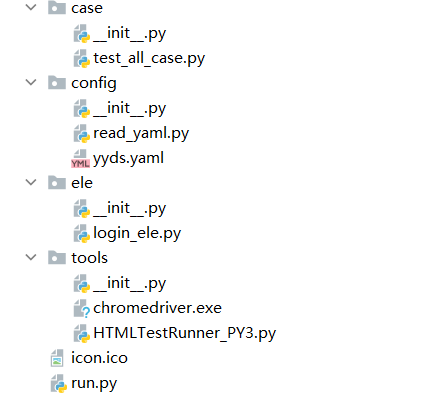Selenium 打包为.exe执行
前言:不依赖环境执行,拓展UI自动化使用的场景
一、项目结构介绍

- case:测试用例次存放目录
- config:主要存放yaml文件配置
- ele:元素的定位以及执行动作
- tools:HTMLTestRunner以及webdriver
- ico:生成exe是的图标
- run:主执行程序
二、代码演示
1.创建 yyds.yaml 以及 read_yaml,py
- yyds.yaml
# yyds.yaml - user_name: bky - pass_word: test666 - base_url: https://account.cnblogs.com/
- read_yaml.py
# coding:utf-8 import yaml import os, sys # 获取当前脚本所在文件夹路径 curPath = os.path.dirname(os.path.realpath(__file__)) # 获取yaml文件路径 # yamlPath = os.path.join(curPath, "yyds.yaml") yamlPath = os.path.join(os.path.dirname(os.path.realpath(sys.executable)), './config/yyds.yaml') # open方法打开直接读出来 f = open(yamlPath, 'r', encoding='utf-8') cfg = f.read() # print(type(cfg)) # 读出来是字符串 # print(cfg) # d = yaml.load(cfg) # 用load方法转字典 d = yaml.load(cfg, Loader=yaml.FullLoader) username = d[0]["user_name"] password = d[1]["pass_word"] baseurl = d[2]["base_url"] print("\nUI自动化") print("\n温馨提示:执行失败请检查Google浏览器版本,当前driver版本104.0.xxx.xxx,如不匹配请自行下载") print("下载地址:http://chromedriver.storage.googleapis.com/index.html\n") print("登录账号:%s\n登录密码:%s\n访问地址:%s" %(username, password, baseurl)) #print(type(d))
2.创建 login.ele.py 以及 test_all_case.py
- login.ele.py
# -*- coding:UTF-8 -*- from selenium.webdriver.common.by import By from time import sleep class Login(): user_loc = (By.ID, "mat-input-0") pass_loc = (By.ID, "mat-input-1") login_loc = (By.XPATH, "//span[contains(.,'登录')]") def user_name(self, driver, name): sleep(1.5) try: driver.find_element(*self.user_loc).send_keys(name) print("\n输入 【%s】 账号成功" %name) except: print("\n输入账号失败") def pass_word(self, driver, word): sleep(1.5) try: driver.find_element(*self.pass_loc).send_keys(word) print("输入 【%s】 密码成功" %word) except: print("输入密码失败") def login_button(self, driver): try: # el_standard = driver.find_element(*self.login_loc) # ActionChains(driver).move_to_element(el_standard).perform() sleep(0.5) driver.find_element(*self.login_loc).click() # el_standard.click() print("登录成功") except: print("登录失败")
- test_all_case.py
# -*- coding:UTF-8 -*- from selenium import webdriver import config.read_yaml from ele.login_ele import Login import unittest from time import sleep from selenium.webdriver.chrome.options import Options ''' ㎡ ''' class Test_all(unittest.TestCase): """BKY FRMO ㎡""" @classmethod def setUpClass(self): global driver option = Options() option.add_experimental_option('useAutomationExtension', False) option.add_experimental_option("excludeSwitches", ['enable-automation']) option.add_argument("disable-blink-features=AutomationControlled") driver = webdriver.Chrome('tools\chromedriver.exe',options=option) print('加载驱动完成 √') driver.maximize_window() # 浏览器全屏显示 driver.get(config.read_yaml.baseurl) print('加载页面完成 √\n') print('正在执行中,请耐心等待...') print('注:测试报告详见此目录下的report.html\n') sleep(10) def test_a_login(self): """【登录】""" Login().user_name(driver, name=config.read_yaml.username) Login().pass_word(driver, word=config.read_yaml.password) Login().login_button(driver)
3.创建 run.py
- run.py
# -*- coding:UTF-8 -*- from tools.HTMLTestRunner_PY3 import HTMLTestRunner import unittest from case.test_all_case import Test_all suit = unittest.TestSuite() suit.addTest(unittest.makeSuite(Test_all)) with open("report.html", 'wb') as f: # 改为with open 格式 HTMLTestRunner(stream=f, title="UI自动化-测试报告", description="演示Demo").run(suit)
4.执行打包命令
- pyinstaller -i lcon.ico -F -c run.py

5.打包成功后出现dist文件夹,将 run.exe 移到与 run.py 同级即可

6.执行测试生成报告
- run.exe



三、扩展
通过输入配置环境

to be continued...



